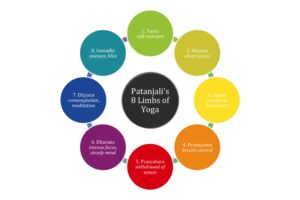Chapter two of the Yoga Sutras of Patanjali is the Sadhana Pada takes us ahead by explaining how one might get into a yogic condition. This section contains 55 sutras explaining yoga as a discipline outlining its eight limbs of yoga or practical aspects.
Table of Contents
ToggleSummary of Sadhana Pada
What Is Kriya Yoga

Since Samadhi is so challenging, we must approach it carefully. Kriya-yoga is the preparatory stage. Kriya yoga means working towards yoga. One must practice austerity or tapas. One must be disciplined. The organs, mind, intellect, and body must be properly controlled by the self. To do this one must study books that teach about liberating the soul. A yogi must only read to boost his judgments.
The two categories of scriptural knowledge are called Vada (the argumentative) and Siddhanta (the conclusive). When a guy is truly uninformed, he engages in the first two: reasoning and arguments. Then he moves on to Siddhanta to draw the judgment. Reaching this conclusion on its own is not enough. It needs to be more intense. Since there are an endless number of books and a limited amount of time, the key to knowing is to focus on what is essential.
After passing the argumentative condition the Yogi has now reached a decision that is unchangeable and is like the rocks. Now all that is left is to make that conclusion stronger. One must avoid arguing. Be silent if someone pushes an argument on one. As arguments disrupt the mind. The mind is a feeble tool that can only provide us with information that is restricted to our senses. Since the Yogi seeks to transcend the senses, intellect serves no purpose for him.
Surrendering the fruits of work to God means giving up both praise and blame to the lord and finding serenity in doing so.
Obstructions In The Path of Discipline

Most of us spoil our mind allowing it to do whatever it wants. Therefore it is necessary to practice kriya yoga to control the mind. The barriers to yoga arise from a lack of control. These are samskaras mentioned in Chapter 1 Samadhi Yoga.
The 5 obstructions are ignorance, egoism, attachment, aversion and clinging to life. Ignorance is the cause of all the other four obstructions. These obstructions are present on many levels.
1. Ignorance
Patanjali mentions four degrees of ignorance.
- In young children, innate tendencies won’t become apparent until later in life. This is also true for yogis who fail to concentrate due to attachments and come back to mortal life to face the same challenges.
- Then there are the seekers of spirituality, who have barriers to enlightenment. Their samskaras are still active because of the previous karmas, but they pose no real threat as long as the aspirant takes precautions to avoid them.
- The obstacles or at least a part of them can be overcome by practicing the right thoughts and virtues. By nurturing these kinds of ideas and qualities, we will eventually lessen the samskaras or barriers.
- Lastly, the barriers could exist in their whole form. This is the tragic state of affairs for all regular folks in this world.
2. Egoism
The sense organs, mind, and intellect, are the instruments to see the external world. Ignorance of egoism is the identification of the Self with the tools. For example, We sometimes claim, “I am angry,” or “I am happy”. How can we feel happy and sad from time to time? Because the self is formless and infinite. But with ignorance, we identify ourselves with pleasure and pain.
3. Attachment
Certain things give us joy, and our minds gravitate toward them. Where there is no pleasure, we are never satisfied.
4. Aversion
Aversion is what makes us suffer we immediately get away from it.
5. Clinging to life
We see this in all animals. We are all so fond of life that we wish for future existence.
Spiritual Discipline – The 8 Limbs of Yoga

The practical information is now presented. Gaining mental and physical control is the first step. The only thing left to do is put the plan into action.
The below spiritual disciplines must be practiced by everyone irrespective of caste and creed.
Yama – five moral guidelines
- Ahimsa (non-violence)
- Satya (truth)
- Asteya (non-stealing)
- Brahmacharya (celibacy)
- Aparigraha (non-hoarding)
Niyama: five guidelines for discipline
- Saucha (purity)
- Santosha (contentment)
- Tapas (austerity)
- Svadhyaya (self study)
- Ishwara Pranidhana (self-surrender)
Asana: postures
Pranayama: control of breath
Pratyahara: withdrawal of the senses
Dharana: concentration
Dhyana – meditation
Samadhi – enlightenment
Yamas & Niyamas
Our goal in life is to ensure that no other being is harmed by our words or behaviors. We must be compassionate and recognize the atman in each person. We must consider ourselves to be always available to assist those in need. However, this does not mean that we should support other’s bad intentions. We must always be truthful. Even when something is accurate, we still need to be careful not to offend people by speaking cruelly. We must keep quiet in these situations.
It’s important to keep in mind that nothing in this world truly belongs to us. It is our responsibility to utilize the world appropriately while only taking what we truly need from it. Stealing from the rest of humanity is when we take more than we need and waste it.
Brahmacharya is consistent in speech, thinking, and conduct. Attaining purity of heart is letting go of the notion of sex. At the same time, one must not hold any attachments to material things.
To be pure is to be clean inside and out. Maintaining a healthy diet is essential for cleansing and strengthening the body’s internal organs. Similarly one must maintain a mental diet to purify the mind. One must control what they read, how we talk, and how much. Engaging in gossip, and fiction stories may give rise to addictions.
To be content implies accepting one’s place in life without feeling jealous or restless. The actions must not be motivated by self-interest or selfish advantage.
Surrendering to god leads to enlightenment. There are four paths to union with god.
Bhakti Yoga
Devotion to god is conveyed through prayer, ceremonial worship, and japam. It is the development of an honest, deep interpersonal bond. It is easiest of all for people who are naturally inclined toward this method.
Karma yoga
The path of selfless action where we dedicate all our actions to god is karma yoga. One can develop wisdom and non-attachment by giving the results of their actions to god. As a result, the spirit finds peace. In the Gita, Sri Krishna primarily tells Arjuna about the practice of karma yoga.
Jnana Yoga
Jnana yoga is the road that involves discriminating against the intellect. It is the path to discover the Brahman by examination and analysis of the true nature of phenomena. This is a challenging road that requires extraordinary willpower and mental clarity.
Raja Yoga
Raja yoga is frequently referred to as the meditational yoga. It focuses on the study of the body as a conduit for spiritual energy. For instance, it discusses the characteristics and function of the mental centers.
These classifications are not rigid. One cannot practice any one yoga style exclusively at the expense of the others. A religious path cannot be followed without love, tolerance, and committed action. Patanjali says that regardless of the style of yoga practiced, adhering to the limbs of yoga is crucial.
Asana
The practice will stay solid if one can control the body with a steady posture and maintain it that way. However, if the body is causing you discomfort, you may lose your focus.
Pranayama
Once posture is mastered, the next step is to control the prana or the life force. We regulate the breath through pranayama. There are three aspects of pranayama. They are inhalation, exhalation, and retention. Prana may be held at different parts of the body for a specific time. The practice of pranayama leads to the awakening of Kundalini.
Another aspect of pranayama is when one has gained full control of prana and the breath may cease on its own during concentration.
Pratyahara
The covering of ignorance is now removed and one can see the inner light. Then arises mastery over the five senses- sight, smell, touch, sound, and taste. When the senses are controlled the yogi can control all feelings and actions.
Now the mind is prepared to concentrate. Dharana and Dhyana are covered in the 3rd chapter of Yoga Sutras of Patanjali called Vibhuti Pada. Samadhi is covered in the 1st Chapter – Samadhi Pada

